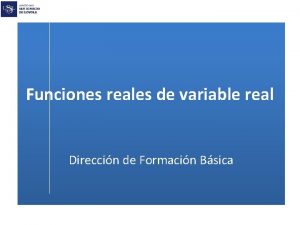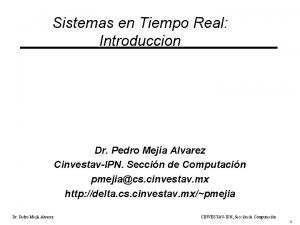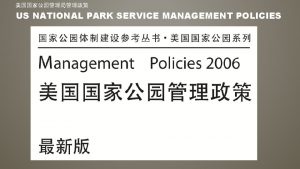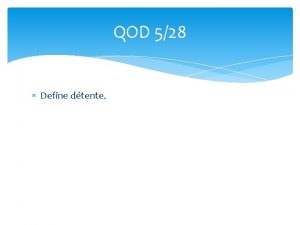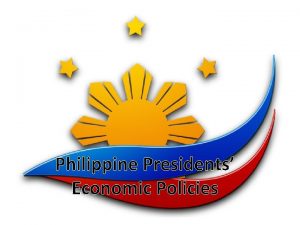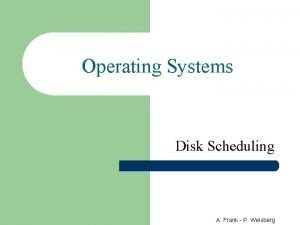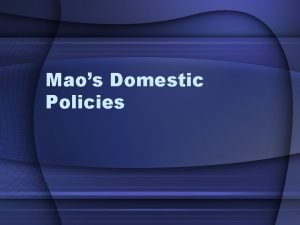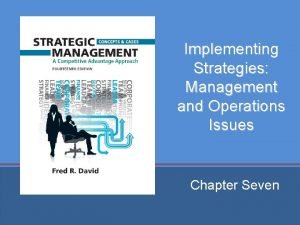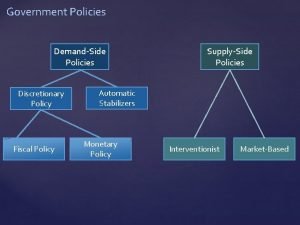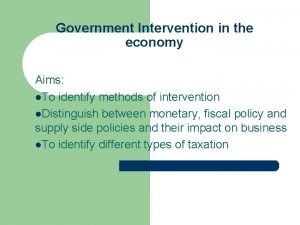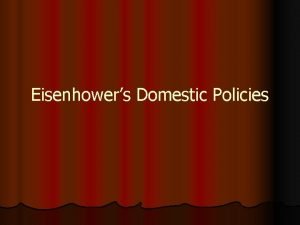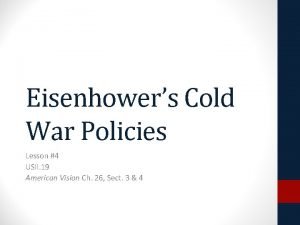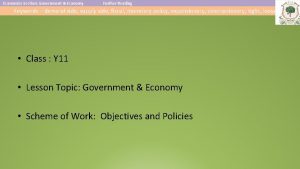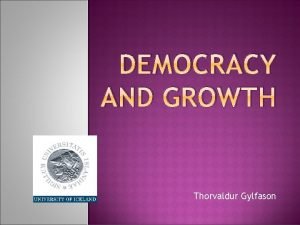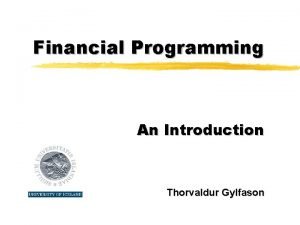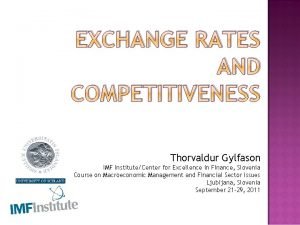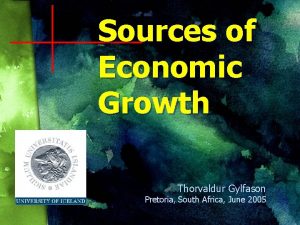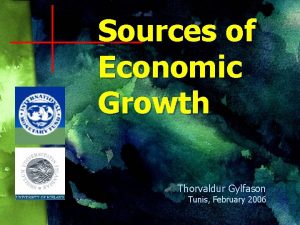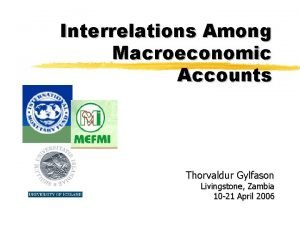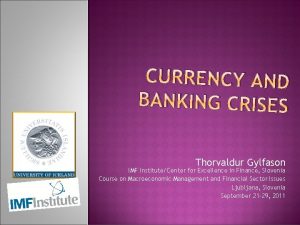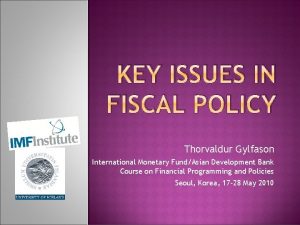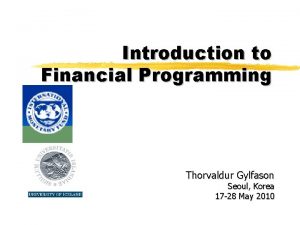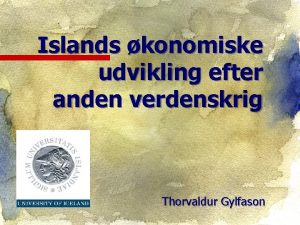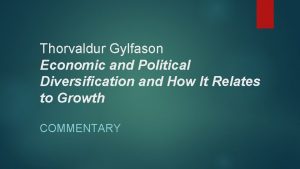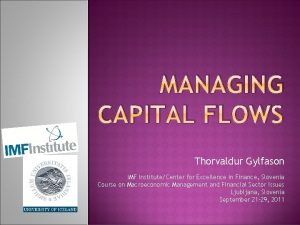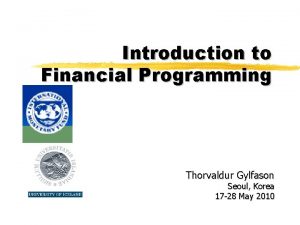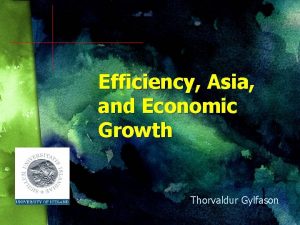External Sector Policies Thorvaldur Gylfason Outline 1 Real













































- Slides: 45

External Sector Policies Thorvaldur Gylfason

Outline 1) Real versus nominal exchange rates 2) Exchange rate policy and welfare 3) The scourge of overvaluation 4) From exchange rate policy to economic growth 5) Exchange rate regimes q To float or not to float

1 Real versus nominal exchange rates Increase in Q means real appreciation Q = real exchange rate e = nominal exchange rate P = price level at home P* = price level abroad e refers to foreign currency content of domestic currency

Real versus nominal exchange rates Devaluation or depreciation of e makes Q also depreciate unless P rises so as to leave Q unchanged Q = real exchange rate e = nominal exchange rate P = price level at home P* = price level abroad

goods, services, and capital Real exchange rate 2 Exchange rate policy and welfare Payments for imports of Imports Equilibrium Earnings from exports of goods, services, and capital Exports Foreign exchange

Exchange rate policy and welfare Equilibrium between demand supply in foreign exchange market establishes üEquilibrium real exchange rate üEquilibrium in the balance of payments BOP = X + Fx – Z – Fz =X–Z+F = current account + capital account =0

Exchange rate policy and R moves when welfare R is fixed Real exchange rate e Deficit Imports Overvaluation Exports Foreign exchange

Price of foreign exchange Exchange rate policy and welfare Overvaluation works like a price ceiling Supply (exports) Overvaluation Deficit Demand (imports) Foreign exchange

Market equilibrium and economic welfare Price A B C Consumer surplus E Producer surplus DR = 0, so R is fixed when e floats Supply Total welfare gain associated with market equilibrium equals producer surplus (= ABE) plus consumer surplus (= BCE) Demand Quantity

Market intervention and economic welfare Price A J Welfare loss F B H C E G Consumer surplus = AFGH Producer surplus = CGH Total surplus = AFGC Supply Price ceiling imposes a welfare loss equivalent to the triangle EFG Price ceiling Demand Quantity

Market intervention and economic welfare Price A J Welfare loss F B H C E G Shortage Supply Price ceiling imposes a welfare loss that results from shortage (e. g. , deficit) Price ceiling Demand Quantity

3 The scourge of overvaluation Governments may try to keep the national currency overvalued To keep foreign exchange cheap To have power to ration scarce foreign exchange To make GNP look larger than it is Other examples of price ceilings üNegative real interest rates üRent controls

Inflation and overvaluation Inflation can result in an overvaluation of the national currency Remember: Q = e. P/P* Suppose e adjusts to P with a lag Then Q is directly proportional to inflation Numerical example

Inflation and overvaluation Real exchange rate Suppose inflation is 10 percent per year 110 105 100 Average Time

Inflation and overvaluation Real exchange rate Suppose inflation rises to 20 percent per year Hence, increased inflation increases the real exchange rate as long as the nominal exchange rate adjusts with a lag 120 110 Average 100 Time

How to correct overvaluation Under a floating exchange rate regime Adjustment is automatic: e moves Under a fixed exchange rate regime Devaluation will lower e and thereby also Q – provided inflation is kept under control Does devaluation improve the current account? The Marshall-Lerner condition

The Marshall-Lerner condition: Theory ed, Suppose prices are fix so that e = Q T = e. X – Z = e. X(e) – Z(e) Not obvious that a lower e helps T Let’s do the arithmetic Valuation Bottom line is: effect arises from Devaluation improves the current the ability account as long as to affect foreign prices a = elasticity of exports b = elasticity of imports

The Marshall-Lerner condition -a Export elasticity 1 + Import b elasticity 1

The Marshall-Lerner e X = Z/e initially m u s s A condition X if

The Marshall-Lerner condition: Evidence Econometric studies indicate that the Marshall-Lerner condition is almost invariably satisfied Industrial countries: a = 1, b = 1 Developing countries: a = 1, b = 1. 5 Hence, Devaluation improves the current account

Empirical evidence from developing countries Argentina Brazil India Kenya Korea Morocco Pakistan Philippines Turkey Average Elasticity of exports imports 0. 6 0. 9 0. 4 1. 7 0. 5 2. 2 1. 0 0. 8 2. 5 0. 8 0. 7 1. 0 1. 8 0. 9 2. 7 1. 4 2. 7 1. 1 1. 5

Small countries: A special case Small countries are price takers abroad üDevaluation has no effect on the foreign currency price of exports and imports So, the valuation effect does not arise Devaluation will, at worst, if exports and imports are insensitive to exchange rates (a = b = 0), leave the current account unchanged Hence, if a > 0 or b > 0, devaluation improves the current account

The importance of appropriate side measures Remember: It is crucial to accompany devaluation by fiscal and monetary restraint in order to prevent prices from rising and thus eating up the benefits of devaluation To work, nominal devaluation must result in real devaluation

4 From exchange rate policy to economic growth Governments may try to keep the national currency overvalued Or inflation may result in overvaluation In either case, overvaluation creates inefficiency, and hurts growth Therefore, exchange rate policy matters for growth Need real exchange rates near equilibrium

From exchange rate policy to economic growth How do we ensure that exchange rates do not stray too far from equilibrium? Either by floating … Then equilibrium follows by itself … or by strict monetary and fiscal discipline under a fixed exchange rate The real exchange rate always floats Through nominal exchange rate adjustment or price change, but this may take time

Why inflation is bad for growth We saw before that inflation leads to overvaluation which hurts exports So, here is one reason why inflation hurts economic growth Exports – and imports! – are good for growth Several other reasons Inflation distorts production and impedes financial development

How trade increases efficiency and growth Trade with other nations increases efficiency by allowing 1. Specialization through comparative advantage 2. Exploitation of economies of scale 3. Promotion of free competition Not only trade in goods and services, but also in capital and labor “Four freedoms”

How trade increases efficiency and growth Trade also encourages international exchange of q q Ideas Information Know-how Technology Trade is education Which is also good for growth!

Efficiency is crucial for economic growth Need economic policies that increase efficiency Produce more output from given inputs Takes fewer inputs to produce given output More efficiency, better technology are two ways of increasing output per unit of input So is more and better education Trade increases efficiency and thereby also economic growth

Trade and growth in Africa in the 1990 s Average ratio of exports to GDP in Africa was 30% against 40% outside Africa Current account deficit in Africa was 7% of GDP against 4% outside Africa Real effective currency depreciation in 15 African countries was 16% Per capita growth in Africa was 0. 2% per year against 1. 3% elsewhere

Openness to FDI and 85 countries growth 1965 -98 r = 0. 62 Botswana An increase in openness to FDI by 2% of GDP is associated with an increase in per capita growth by more than 1% per year

Openness to Trade and 87 countries Growth 1965 -98 r = 0. 42 Korea Malaysia Belgium Guinea Bissau An increase in openness by 14% of GDP is associated with an increase in per capita growth by 1% per year

Tariffs and Growth 82 countries 1965 -98 Botswana An increase in tariffs by 10% of imports is associated with a decrease in per capita growth by 1% per year India Cote d'Ivoire r = -0. 52

African countries: Exports 2001 (% of GDP) Botswana Average

AFRITAC countries: Exports 1960 -2001 (% of GDP) Botswana Weighted averages. Unweighted averages are higher: 33% for Africa and 42% for world as a whole.

5 Exchange rate regimes The real exchange rate always floats Through nominal exchange rate adjustment or price change Even so, it makes a difference how countries set their nominal exchange rates because floating takes time There is a wide spectrum of options, from absolutely fixed to completely flexible exchange rates

Exchange rate regimes There is a range of options Monetary union or dollarization üMeans giving up your national currency or sharing it with others Currency board üLegal commitment to exchange domestic foreign currency at a fixed rate Fixed exchange rate (peg) Crawling peg Managed floating Pure floating

Benefits and costs Benefits Fixed exchange rates Floating exchange rates Costs

Benefits and costs Benefits Fixed exchange rates Floating exchange rates Stability of trade and investment Low inflation Costs

Benefits and costs Fixed exchange rates Floating exchange rates Benefits Costs Stability of trade and investment Low inflation Inefficiency BOP deficits Sacrifice of monetary independence

Benefits and costs Benefits Costs Fixed exchange rates Stability of trade and investment Low inflation Inefficiency BOP deficits Sacrifice of monetary independence Floating exchange rates Efficiency BOP equilibrium

Benefits and costs Benefits Costs Fixed exchange rates Stability of trade and investment Low inflation Floating exchange rates Efficiency BOP equilibrium Inefficiency BOP deficits Sacrifice of monetary independence Instability of trade and investment Inflation

Exchange rate regimes In view of benefits and costs, no single exchange rate regime is right for all countries at all times The regime of choice depends on time and circumstance üIf inefficiency and slow growth are the main problem, floating rates can help üIf high inflation is the main problem, fixed exchange rates can help

What countries actually do (2001) No national currency Currency board Adjustable pegs Crawling pegs Managed floating Pure floating 39 8 50 9 33 47 186 There is a gradual tendency towards floating, from 10% of LDCs in 1975 to over 50% today 25% 50% 25%

These slides will be posted on my website: www. hi. is/~gylfason Bottom line Exchange rate policy is important because trade is important Need to maintain real exchange rates at levels that are consistent with BOP equilibrium, including sustainable debt d n E e h T § Avoid overvaluation! Need to adopt exchange rate regime that is conducive to low inflation and rapid growth
 Haukur freyr gylfason
Haukur freyr gylfason Haukur freyr gylfason
Haukur freyr gylfason Freyr gylfason
Freyr gylfason Haukur freyr gylfason
Haukur freyr gylfason Haukur freyr gylfason
Haukur freyr gylfason External-external trips
External-external trips What is sentence outline
What is sentence outline Funcion variable real
Funcion variable real The real real fashion copywriter
The real real fashion copywriter Sensor and (tiempo real or real time)
Sensor and (tiempo real or real time) Polynomials real life examples
Polynomials real life examples Marketing: real people, real choices
Marketing: real people, real choices The real thing short story
The real thing short story Marketing real people real choices
Marketing real people real choices Southpointe village apartments fishers in
Southpointe village apartments fishers in Slidetodoc.com
Slidetodoc.com Marketing real people real decisions
Marketing real people real decisions Marketers classify innovations based on their
Marketers classify innovations based on their Nps management policies
Nps management policies Sdlc principles and practices
Sdlc principles and practices Nixons foreign policies
Nixons foreign policies Crime control policies
Crime control policies What are policies
What are policies Manuel roxas economic policies
Manuel roxas economic policies What is disk scheduling in os
What is disk scheduling in os National policy and legislation related to child health
National policy and legislation related to child health Anti natalist policy
Anti natalist policy Graphing monetary and fiscal policy interactions
Graphing monetary and fiscal policy interactions Emigration ap human geography
Emigration ap human geography Fear be conquered
Fear be conquered Macroprudential policy
Macroprudential policy Crime control policies
Crime control policies Divisional structure advantages and disadvantages
Divisional structure advantages and disadvantages Hr policies and practices
Hr policies and practices Demand side policies
Demand side policies Interventionist supply side policies
Interventionist supply side policies Eisenhower domestic policies
Eisenhower domestic policies Lesson 4 eisenhower's cold war policies
Lesson 4 eisenhower's cold war policies Demand side policies
Demand side policies Crime control policies
Crime control policies Database security policy
Database security policy Decs order no. 11 s. 1987 summary
Decs order no. 11 s. 1987 summary Neoclassical theory criminology
Neoclassical theory criminology Classroom policies and procedures
Classroom policies and procedures Working capital management decisions help to determine
Working capital management decisions help to determine Crime control policies
Crime control policies







